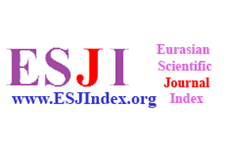STOCK QUOTES FOR US TECHNOLOGY COMPANIES AS A TOOL FOR SELECTING POTENTIAL AREAS FOR STARTUP IMPLEMENTATION
Iryna Pyvavar
Department of Public Administration and Economic Policy, Simon Kuznets Kharkiv National University of Economics, Ukraine
Pavlo Samus
Department of Business, Trade and Logistics, National Technical University «Kharkiv Polytechnic Institute», Ukraine
Samer Mehyar
Head of project and assets accounts at the Jordan Petroleum Refinery, Amman, Jordan
##semicolon## Shares, Quotes, Dynamics, Startup, Stock market, Technology companies, Business idea, Statistical analysis
सार
Increasingly, economic research is paying attention to the technological development of various economic entities. In this case, special attention is paid to the implementation of some business ideas based on startups. This attention to certain areas of economic research is based both on their importance from the point of view of economic development, and on the possibility of introducing innovative solutions in the shortest possible time. The main problem in this aspect is attracting a sufficient amount of financial resources in the shortest possible time. Based on this, the paper examines the dynamics of quotes for shares of technology companies. To solve the problem, the absolute values of such quotes were considered and the corresponding statistical analysis was carried out. As a result, the potential time periods for entering the corresponding segment of the stock market were substantiated.
##submission.citations##
Bustos, O., & Pomares-Quimbaya, A. (2020). Stock market movement forecast: A systematic review. Expert Systems with Applications, 156, 113464.
Nti, I. K., Adekoya, A. F., & Weyori, B. A. (2020). A systematic review of fundamental and technical analysis of stock market predictions. Artificial Intelligence Review, 53(4), 3007-3057.
Bhowmik, R., & Wang, S. (2020). Stock market volatility and return analysis: A systematic literature review. Entropy, 22(5), 522.
Baek, S., Mohanty, S. K., & Glambosky, M. (2020). COVID-19 and stock market volatility: An industry level analysis. Finance research letters, 37, 101748.
Baranova, V., Zeleniy, O., Deineko, Z., & Lyashenko, V. (2019, October). Stochastic Frontier Analysis and Wavelet Ideology in the Study of Emergence of Threats in the Financial Markets. In 2019 IEEE International Scientific-Practical Conference Problems of Infocommunications, Science and Technology (PIC S&T) (pp. 341-344). IEEE.
Vasiurenko, O., Lyashenko, V., Baranova, V., & Deineko, Z. (2020). Spatial-Temporal Analysis the Dynamics of Changes on the Foreign Exchange Market: an Empirical Estimates from Ukraine. Journal of Asian Multicultural Research for Economy and Management Study, 1(2), 1-6.
Oranburg, S. C. (2020). Start-up financing. In Start-Up Creation (pp. 59-79). Woodhead Publishing.
Klein, M., Neitzert, F., Hartmann-Wendels, T., & Kraus, S. (2019). Start-up financing in the digital age: A systematic review and comparison of new forms of financing. The Journal of Entrepreneurial Finance (JEF), 21(2), 46-98.
Lyashenko, V. (2014). Efficiency of bank crediting of real sector of economy in the context of separate banking groups: an empirical example from Ukraine. International Journal of Accounting and Economics Studies, 2(2), 74-79.
Слюніна, Т. Л., Бережний, Є. Б., & Ляшенко, В. В. (2007). Розвиток вітчизняної мережі банківських установ: особливості та регіональні аспекти. Вісник ХНУ ім. В. Н. Каразіна. Економічна серія, 755. 84–88.
Куштим, В. В., & Ляшенко, В. В. (2007). Динаміка розвитку банківського сегмента міжнародного фінансового ринку. Фінанси України, 12, 96-105.
Азаренкова, Г., & Ляшенко, В. (2009). Відношення переваг у порівняльній оцінці діяльності банків. Банківська справа, 5, 65-72.
Dobrovolskaya, I., & Lyashenko, V. (2013). Interrelations of banking sectors of European economies as reflected in separate indicators of the dynamics of their cash flows influencing the formation of the resource potential of banks. European Applied Sciences, 1-2, 114-118.
Kuzemin, A., & Lyashenko, V. (2006). Fuzzy set theory approach as the basis of analysis of financial flows in the economical security system. International Journal Information Theories & Applications, 13(1), 45-51.
Babker, A. M., Altoum, A. E. A., Tvoroshenko, I., & Lyashenko, V. (2019). Information technologies of the processing of the spaces of the states of a complex biophysical object in the intellectual medical system health. International Journal of Advanced Trends in Computer Science and Engineering, 8(6), 3221-3227.
Matarneh, R., Tvoroshenko, I., & Lyashenko, V. (2019). Improving Fuzzy Network Models For the Analysis of Dynamic Interacting Processes in the State Space. International Journal of Recent Technology and Engineering, 8(4), 1687-1693.
Kuzemin, A., & Lyashenko V. (2011). Microsituation Concept in GMES Decision Support Systems. In Intelligent Data Processing in Global Monitoring for Environment and Security, 217–238.
Dadkhah, M., Lyashenko, V. V., Deineko, Z. V., Shamshirband, S., & Jazi, M. D. (2019). Methodology of wavelet analysis in research of dynamics of phishing attacks. International Journal of Advanced Intelligence Paradigms, 12(3-4), 220-238.
Sotnik, S., Mustafa, S. K., Ahmad, M. A., Lyashenko, V., & Zeleniy, O. (2020). Some features of route planning as the basis in a mobile robot. International Journal of Emerging Trends in Engineering Research, 8(5), 2074-2079.
Nevliudov, I., Yevsieiev, V., Lyashenko, V., & Ahmad, M. A. (2021). GUI Elements and Windows Form Formalization Parameters and Events Method to Automate the Process of Additive Cyber-Design CPPS Development. Advances in Dynamical Systems and Applications, 16(2), 441-455.
Mustafa, S. K., Yevsieiev, V., Nevliudov, I., & Lyashenko, V. (2022). HMI Development Automation with GUI Elements for Object-Oriented Programming Languages Implementation. SSRG International Journal of Engineering Trends and Technology, 70(1), 139-145.
Kuzomin, O., Lyashenko, V., Tkachenko, M., Ahmad, M. A., & Kots, H. (2016). Preventing of technogenic risks in the functioning of an industrial enterprise. International Journal of Civil Engineering and Technology, 7(3), 262-270.
Omarov, M., Tikhaya, T., & Lyashenko, V. (2018). Internet marketing technologies in civil engineering. International Journal of Civil Engineering and Technology, 9(7), 1233-1240.
Lyashenko, V., Zeleniy, O., Mustafa, S. K., & Ahmad, M. A. (2019). An advanced methodology for visualization of changes in the properties of a dye. International Journal of Engineering and Advanced Technology, 9(1), 711-7114.
Vyacheslav, L., Omer, I. A. M., & Asaad, M. A. B. (2020). COVID-19 wavelet coherence data for some Gulf countries. GSC Biological and Pharmaceutical Sciences, 11(2), 166-174.
Ahmad, M. A., Kots, G. P., & Lyashenko, V. V. (2016). Statistical Study of Bank Lending Efficiency in the Real Sector of the Economy of Ukraine within the Period of Years 2009 to 2012. Asian Academic Research Journal of Multidisciplinary, 3(2), pp. 104-120.
Kousari, A. (2011). New solutions to the funding dilemma of technology startups. Open Source Business Resource, (June 2011).
Klačmer Čalopa, M., Horvat, J., & Lalić, M. (2014). Analysis of financing sources for start-up companies. Management: journal of contemporary management issues, 19(2), 19-44.
Dos Santos, B. L., Patel, P. C., & D’Souza, R. R. (2011). Venture capital funding for information technology businesses. Journal of the Association for Information Systems, 12(1), 2.
Halt Jr, G. B., Donch Jr, J. C., Stiles, A. R., & Fesnak, R. (2016). Intellectual Property and Financing Strategies for Technology Startups. Springer.
Savin, I., Chukavina, K., & Pushkarev, A. (2023). Topic-based classification and identification of global trends for startup companies. Small Business Economics, 60(2), 659-689.
Vandenberg, P., Hampel-Milagrosa, A., & Helble, M. (2020). Financing of tech startups in selected Asian countries (No. 1115). ADBI Working Paper Series.
Torrence, С., & Webster, P. J. (1999). Interdecadal changes in the ENSO–monsoon system. Journal of climate, 12(8), 2679-2690.
Heil, C.E., & Walnut, D.F. (1989). Continuous and discrete wavelet transforms. SIAM review, 31(4), 628- 666.
Kingsbury, N. (1999). Image processing with complex wavelets. Philosophical Transactions of the Royal Society of London. Series A: Mathematical, Physical and Engineering Sciences, 357(1760), 2543-2560.
Vasiurenko, O., & Lyashenko, V. (2020). Wavelet coherence as a tool for retrospective analysis of bank activities. Economy and Forecasting, (2), 43-60.
Baranova, V., Orlenko, O., Vitiuk, A., Yakimenko-Tereschenko, N., & Lyashenko, V. (2020). Information system for decision support in the field of tourism based on the use of spatio-temporal data analysis. International Journal of Advanced Trends in Computer Science and Engineering, 9(4), 6356-6361.
Dadkhah, M., Lyashenko, V., & Jazi, M. (2015). Methodology of the Chaos Theory in research of phishing attacks. International Journal of Academic Research, 7(1), 169-175.
Orhan, A., Kirikkaleli, D., & Ayhan, F. (2019). Analysis of wavelet coherence: service sector index and economic growth in an emerging market. Sustainability, 11(23), 6684.
Kirikkaleli, D., & Gokmenoglu, K. K. (2020). Sovereign credit risk and economic risk in Turkey: empirical evidence from a wavelet coherence approach. Borsa Istanbul Review, 20(2), 144-152.
Wang, Y., Wei, M., Bashir, U., & Zhou, C. (2022). Geopolitical risk, economic policy uncertainty and global oil price volatility—an empirical study based on quantile causality nonparametric test and wavelet coherence. Energy Strategy Reviews, 41,

















